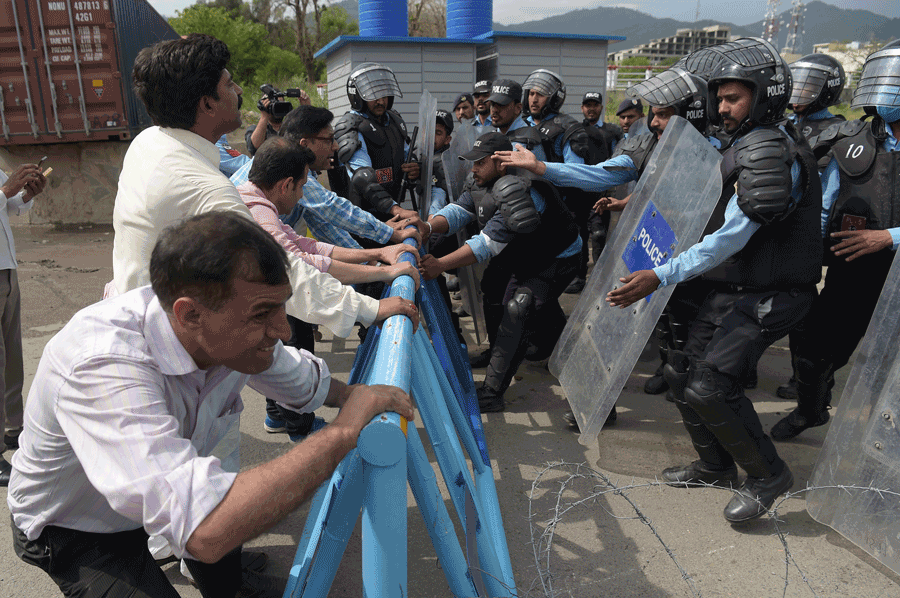To Print or Not to Print?
By Ayesha Azfar | Cover Story | Published 6 years ago
We may not have reached the point of total capitulation. Thanks to the decades-long struggle of Pakistani journalists, pockets of resistance still exist. But the overall decline is inexorable. The state, even in presumably democratic times, continues to suffocate and silence opinion, and is aided in its endeavours by those who easily lend themselves to its machinations. Today’s journalist is under attack: from the state, from society, from non-state groups, and indeed, from sections of the media – print, electronic and social – itself.

Police stop journalists from rallying in Islamabad, on World Press Freedom Day.
With the once black-and-white censorship ‘rules’ now in a state of flux, editors, section in-charges, reporters, illustrators, cartoonists, photographers and subeditors in newspapers are all affected. I edit the opinion pages of Dawn. Over the years, selecting, commissioning and editing opinion pieces and leaders has become a considerable challenge. The fact that Dawn has been specifically targeted by the security establishment since 2016 – evident in the Dawn Leaks saga – has only compounded matters. And then there is the obvious concern of being maligned by elements in the media. Campaigns on social media against Dawn have been particularly vicious. Also, Pakistani society has witnessed a rise in religious vigilantism. In such an environment, exercising caution has become second nature.
Truth is the bedrock principle that newspapers must abide by. But journalists often find themselves on the lookout for different ways to express it, especially when space is shrivelling up. ‘Toning down’ an otherwise hard-hitting article; a liberal sprinkling of the word ‘alleged’ or the phrase ‘many believe’; pulling back from commissioning or selecting more than a couple of articles on an evolving debate that is frowned upon by the state – these are all depressing signs of the direction in which we are headed. One has to always think of the consequences. How many articles can we take on the PTM without bringing down upon us the wrath of the powers that be? How far can we go in our sympathy for persecuted religious communities, reviled by society itself, without inviting trouble for our correspondents living in conservative milieus?

By writing bold, unsparing editorials, how do we know that our distribution won’t be affected the next day? Or that social media trolls won’t bare their teeth? What if we haven’t yet discovered that the rules of the game have changed and that the scope of treason – a capital offence – has been broadened once more? Will there be irate phone calls if we mess up yet again and write ‘killed’ instead of ‘martyred’? Are we concentrating enough on the fine distinction between ‘occupied’ and ‘held’ in the case of disputed territory? And then there’s the eternal ‘militant-fighter-insurgent-terrorist’ enigma that continues to plague the editorial mind.
It used to be much simpler some years ago when not everyone felt hurt or got annoyed so quickly, when there was still a little more room to breathe. But today, there are several, psychologically taxing, questions before the editor or section head reviewing the report or article before him/her.
It is getting more and more difficult for newspapers committed to defending free thought and expression to promote a vibrant discourse when the onslaught of a unidimensional narrative is so unrelenting.
In such a situation, guerrilla tactics (hit and retreat to live another day) might hold appeal. But it is tiring in the long run. More useful would be the media industry’s collective voice that unequivocally condemns all those who, through threats and force and ‘advice’, assert themselves in the space that is meant for democratic thinking and progressive values, including freedom of expression.


